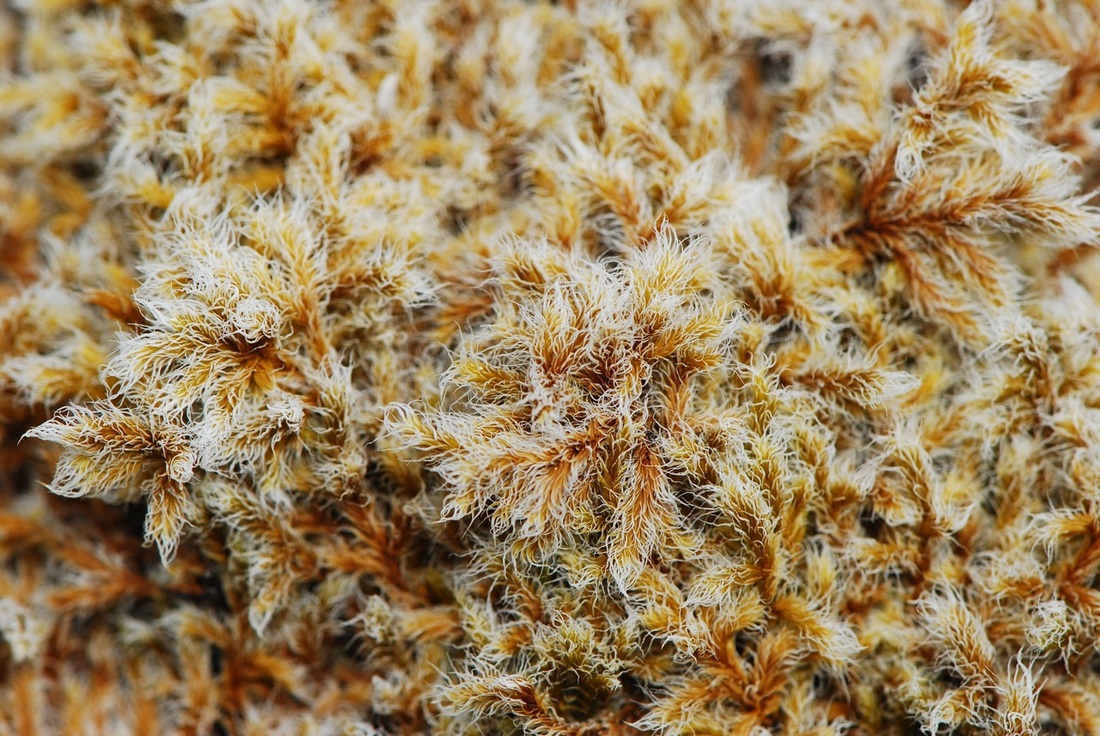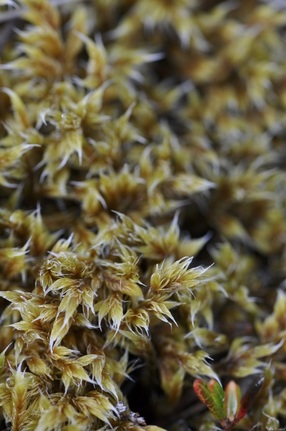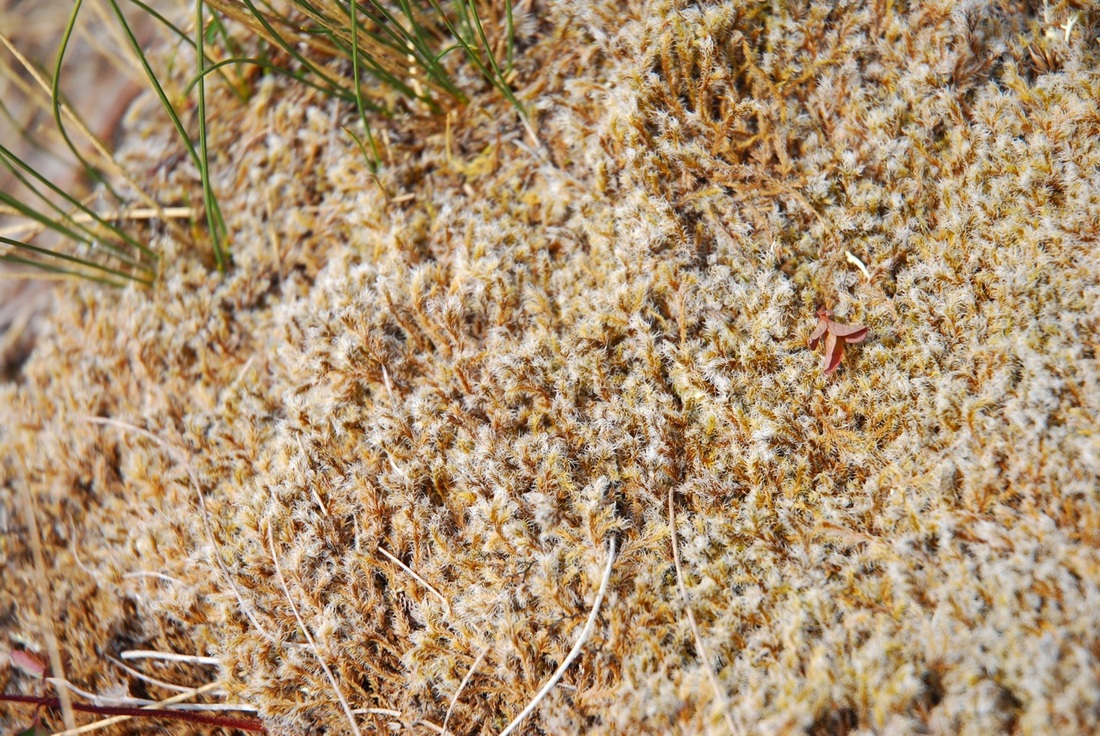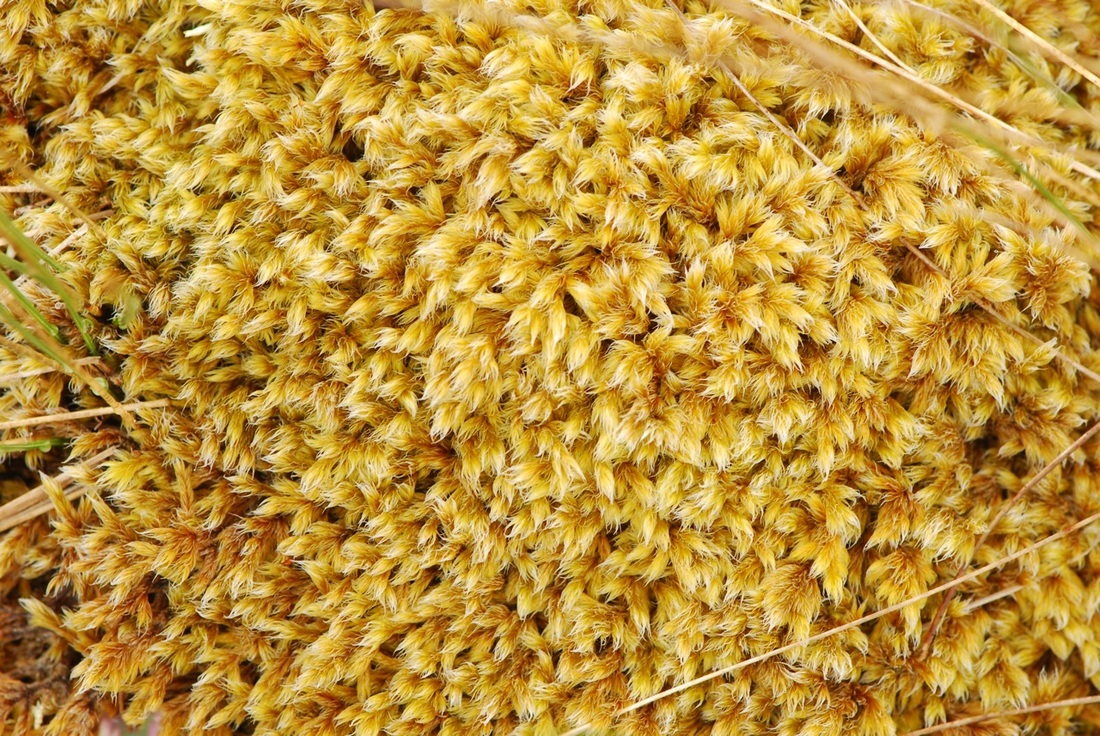Hoary rock moss • Racomitrium lanuginosum
{Lanuginosum = softly hair, woolly, or cottony}
|
Hoary rock moss has a distinctly different appearance when wet (bottom right) than when dry (centre right and top photos). Photos by Kira Hoffman (bottom left) and Kelly Fretwell.
|
Identification
Hoary rock moss varies in colour depending on moisture: it can be greyish-green, brownish, whitish-yellow, or off-white. Moist plants are darker in colour. Dry plants in particular have conspicuous whitish-grey tips (awns), giving them a downy or cottony appearance that led to the species' common name. Hoary rock moss has irregularly branching stems to 12 cm long. These stems grow partially or fully upright. The awn-tipped leaves are somewhat wavy or zig-zagged when dry, giving plants a roughened appearance. The leaves are 3-4.5 mm long, lance-shaped and pointed with a strong midrib. The cells near the leaf-tips are clear and bumpy. Plants occasionally have sporophytes - these grow from the plant tips, and may be abundant on plants in coastal areas.
Habitat & Range
Hoary rock moss forms large cushiony mats on exposed acidic rock and in peatlands and bogs. It is occasionally epiphytic at higher elevations. It grows at all elevations in coastal regions, and in dry alpine tundra inland. It grows all along the west coast of North America to California, and is found throughout much of northern and eastern North America. It is a circumpolar species in the Northern Hemisphere, and also grows in some sub-Antarctic regions in the Southern Hemisphere.
Similar Species
Similar species include roadside rock moss (Racomitirum canescens), yellow-green rock moss (R. heterostichum), and fringed hoar-moss (Hedwigia ciliata). The leaves with bumpy, transparent tips (when examined with a lens) and a midrib, combined with an overall whitish-grey tinge, are fairly distinctive features of hoary rock moss.
iNaturalist
https://www.inaturalist.org/taxa/167684-Racomitrium-lanuginosum
Hoary rock moss varies in colour depending on moisture: it can be greyish-green, brownish, whitish-yellow, or off-white. Moist plants are darker in colour. Dry plants in particular have conspicuous whitish-grey tips (awns), giving them a downy or cottony appearance that led to the species' common name. Hoary rock moss has irregularly branching stems to 12 cm long. These stems grow partially or fully upright. The awn-tipped leaves are somewhat wavy or zig-zagged when dry, giving plants a roughened appearance. The leaves are 3-4.5 mm long, lance-shaped and pointed with a strong midrib. The cells near the leaf-tips are clear and bumpy. Plants occasionally have sporophytes - these grow from the plant tips, and may be abundant on plants in coastal areas.
Habitat & Range
Hoary rock moss forms large cushiony mats on exposed acidic rock and in peatlands and bogs. It is occasionally epiphytic at higher elevations. It grows at all elevations in coastal regions, and in dry alpine tundra inland. It grows all along the west coast of North America to California, and is found throughout much of northern and eastern North America. It is a circumpolar species in the Northern Hemisphere, and also grows in some sub-Antarctic regions in the Southern Hemisphere.
Similar Species
Similar species include roadside rock moss (Racomitirum canescens), yellow-green rock moss (R. heterostichum), and fringed hoar-moss (Hedwigia ciliata). The leaves with bumpy, transparent tips (when examined with a lens) and a midrib, combined with an overall whitish-grey tinge, are fairly distinctive features of hoary rock moss.
iNaturalist
https://www.inaturalist.org/taxa/167684-Racomitrium-lanuginosum
References
Ellis, S. Racomitrium lanuginosum (Hedw.) Brid. Introduction to Bryophytes. Biology 321, Department of Biology, University of British Columbia, Vancouver. Accessed 11/08/2014.
Pojar, J. and MacKinnon, A. (1994). Plants of Coastal British Columbia. Vancouver, BC: Lone Pine Publishing. P. 483.
Schofield, W. Racomitrium lanuginosum (Hedw.) Brid. In Klinkenberg, Brian. (Ed.). E-Flora BC: Electronic Atlas of the Plants of British Columbia. Lab for Advanced Spatial Analysis, Department of Geography, University of British Columbia, Vancouver. Accessed 11/08/2014.
Authors and editors of page
Kelly Fretwell and Brian Starzomski (2014).
Ellis, S. Racomitrium lanuginosum (Hedw.) Brid. Introduction to Bryophytes. Biology 321, Department of Biology, University of British Columbia, Vancouver. Accessed 11/08/2014.
Pojar, J. and MacKinnon, A. (1994). Plants of Coastal British Columbia. Vancouver, BC: Lone Pine Publishing. P. 483.
Schofield, W. Racomitrium lanuginosum (Hedw.) Brid. In Klinkenberg, Brian. (Ed.). E-Flora BC: Electronic Atlas of the Plants of British Columbia. Lab for Advanced Spatial Analysis, Department of Geography, University of British Columbia, Vancouver. Accessed 11/08/2014.
Authors and editors of page
Kelly Fretwell and Brian Starzomski (2014).








